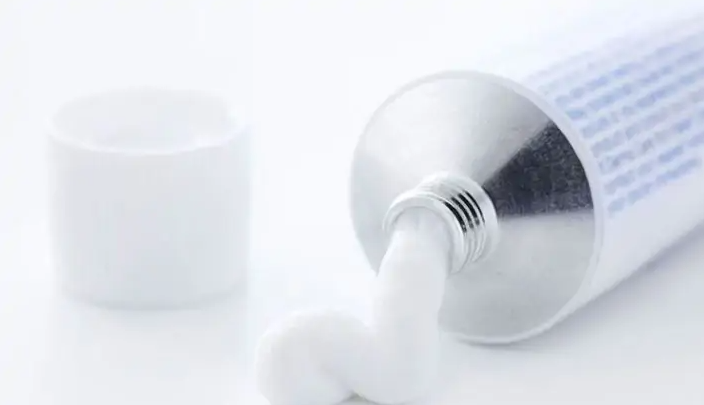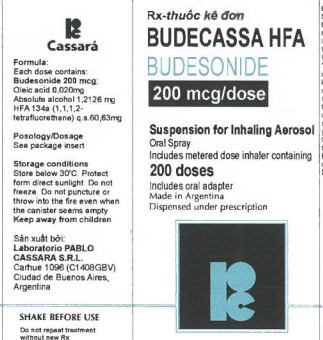What is Dermovate Cream and how does it work?
This is an automatically translated article.
Corticosteroids are one of the most commonly used active ingredients, both systemic or topical. The effects of this drug are varied and relatively effective if used correctly. One of them is Dermovate cream for topical application. So what is Dermovate cream and what diseases it treats?
1. What is Dermovate cream?
The ingredients of Dermovate topical cream are Clobetasol propionate 0.05% (kl/kl) and excipients such as: Glyceryl monostearate, Cetostearyl alcohol, Chlorocresol, Sodium citrate, Citric acid, purified water, Arlacel 165, Beeswax substitute 6621, Propylene glycol...
2. Pharmacodynamics and pharmacokinetics of Dermovate cream
2.1. Pharmacodynamics The topical corticosteroid component in Dermovate cream acts as an anti-inflammatory agent through multiple mechanisms of inhibition of late-phase allergic reactions, including reduction in mast cell density, chemotaxis, and eosinophil activation acidosis, reduction of cytokine production from lymphocytes, monocytes, mast cells and eosinophils and inhibition of arachidonic acid metabolism.
2.2. Pharmacokinetics Absorption: Topical corticosteroids can be absorbed systemically through the surface of normal intact skin. The extent of absorption through the skin depends on many factors, including the excipients and the integrity of the skin's epidermal barrier; Distribution: The use of pharmacodynamic criteria to assess systemic exposure to topical corticosteroids is necessary because blood concentrations are much lower than detectable concentrations; Metabolism: When absorbed through the skin, topical corticosteroids undergo the same pharmacokinetics as systemic corticosteroids. The drug is metabolized mainly in the liver; Elimination: Topical corticosteroids are eliminated primarily by the kidneys. In addition, some corticosteroids and their metabolites are eliminated via the bile.
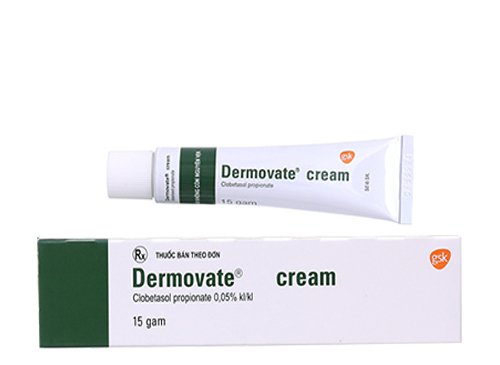
"Dermovate cream là thuốc gì?" đây là thắc mắc của nhiều người bệnh hiện nay
3. What does Dermovate cream treat?
What does Dermovate cream treat? Dermovate is a highly potent topical corticosteroid indicated for use in adults, the elderly and children over 12 years of age. Dermovate cream is used to relieve the inflammatory and pruritic symptoms of steroid-responsive skin diseases including:
Psoriasis (except widespread plaques); Intractable persistent dermatitis; Flat lichen; Discoid lupus erythematosus; Other skin diseases do not respond to lower potency steroids.
4. Dosage of Dermovate topical cream
Dermovate topical cream is suitable for wet or oozing skin surfaces.
4.1. Dosage for adults, the elderly and children over 12 years of age Patients apply a thin layer of medicine and gently massage, just enough to completely cover the affected area, apply the drug 1 or 2 times a day for 4 weeks until the condition improved skin condition. Then reduce the number of times the drug is used or switch to a less potent drug. After each application of Dermovate topical cream, it is necessary to allow enough time for the drug to be absorbed into the skin before applying emollients. Short courses of Dermovate topical cream may be repeated to control flare-ups.
In cases of difficult-to-treat skin lesions, especially in the presence of hyperkeratosis, the effect of Dermovate topical cream can, if necessary, be enhanced by occluding the treated area with a polythene film. Usually, just covering the skin overnight is enough to bring about the desired response of the drug, subsequent times just applying the medicine without the bandage can still maintain the improvement. If the condition worsens or does not improve within 2-4 weeks of using Dermovate topical cream, the physician should reevaluate treatment and diagnosis.
Do not prolong treatment with Dermovate topical cream for more than 4 weeks, if necessary continue treatment should use less potent drugs. Note that the maximum weekly dose of Dermovate topical cream should not exceed 50g/week.
4.2. Atopic dermatitis When the disease is under control, treatment with Dermovate topical cream should be discontinued gradually and continued with another emollient. Skin diseases may recur when Dermovate topical cream is stopped abruptly without a gradual dose reduction.
4.3. Intractable Persistent Dermatitis When an exacerbation has been effectively treated with continuous topical corticosteroids, patients should consider intermittent dosing (once daily, twice weekly, no occlusive dressings) to provide relief. recurrence frequency. Continue to apply the drug to areas of skin that have been affected or may recur in combination with an emollient applied daily.
4.4. Dosage in children Dermovate topical cream is contraindicated in children under 12 years of age because children are more likely to experience local and systemic side effects than when using topical corticosteroids. require shorter duration of drug therapy with less potent drugs than in adults.
4.5. Dosage in the Elderly No difference in the therapeutic response of Dermovate was found between the elderly and younger patients. If systemic absorption occurs with Dermovate topical cream, elimination may be slower in the elderly due to impaired liver or kidney function. The minimum amount of Dermovate topical cream should be used for the shortest possible time to achieve the desired clinical effect.
4.6. Dosage in patients with hepatic/renal impairment When extensive application for a long period of time may lead to systemic absorption, hepatic/renal impairment may slow metabolism and elimination of the drug, increasing the risk of systemic toxicity.
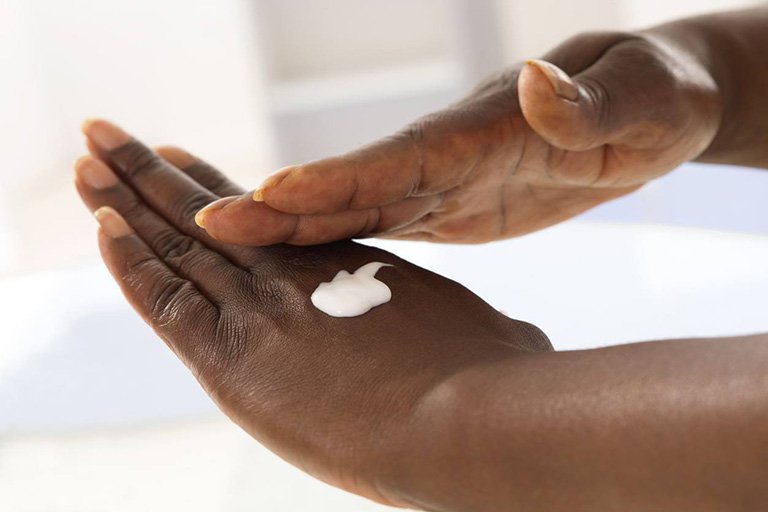
Dermovate Cream công dụng phát huy tốt nhất khi bạn sử dụng đúng cách
5. Contraindications of Dermovate topical cream
Do not treat Dermovate topical cream in the following cases:
Untreated skin infections; rosacea ; Acne; Itching but not inflammation; Itching around the anus and genital area; Inflammation of the skin around the mouth; Hypersensitivity to Dermovate topical cream; Viral infection; Fungal infections; Extensive plaque psoriasis; Children under 12 years old, including inflammatory skin diseases.
6. Some warnings during the use of Dermovate cream
Patients with a history of local allergy or hypersensitivity to corticosteroids or other ingredients in Dermovate topical cream should be treated with extreme caution before and during use.
Cushing's syndrome is secondary to elevated cortisol, causing reversible inhibition of the hypothalamic-pituitary-adrenal axis and consequent glucocorticosteroid hormone deficiency. This phenomenon may occur in some cases due to increased absorption of topical steroids, including Dermovate. If this occurs, the patient should gradually discontinue use of this product (reduce the frequency of application or substitute with a less potent corticosteroid). Note that abrupt discontinuation of Dermovate cream may lead to glucocorticosteroid deficiency.
Some risk factors may increase the systemic effects of Dermovate cream, including:
Duration of drug use; Apply the drug on a large area of the skin; Apply the medicine to closed skin, including skin folds or covered with bandages; Increases hydration of the stratum corneum; Apply dermovate to thin areas of skin such as the face; Apply on the wound area when the skin barrier has been damaged; Children's bodies are more able to absorb topical corticosteroids than adults, so the risk of systemic side effects is higher. This is because the skin barrier in children is still weak and the ratio of skin surface area to weight is higher than that of adults. Children are at increased risk of skin atrophy when using topical corticosteroids, so treatment with Dermovate cream should be limited to a short duration.
The risk of skin infections in inconspicuous places is higher because warm, humid conditions in the folds or when the skin is covered with bandages will create favorable conditions for bacteria to grow and cause disease. Therefore, users need to clean the affected area before dressing
Caution should be taken when using topical corticosteroids (such as Dermovate cream) to treat psoriasis. According to statistics, some cases of psoriasis treated with corticosteroids have the risk of recurrence, progression to systemic pustular psoriasis, increased systemic/local toxicity (due to damaged skin barrier). Therefore, if corticosteroids are indicated for the treatment of psoriasis, it is important to plan for careful patient monitoring.
Dermovate or corticosteroid cream should not be applied to the face because the risk of skin atrophy is very high. The use of Dermovate cream on the face should be limited to a few days.
If the drug is applied to the skin around the eyelids, the patient should be careful not to get the medicine in the eyes because of the risk of cataract and glaucoma formation with prolonged exposure.
7. Undesirable effects of Dermovate
Side effects of Dermovate cream may include:
Increased risk of onset of opportunistic infections (very rare however); Endocrine disorders: Inhibition of the hypothalamic-pituitary-adrenal axis with manifestations similar to Cushing's syndrome (e.g., round face like moon, central body fat), delayed weight gain/slow growth in children , osteoporosis, glaucoma, hyperglycemia/glucoseuria, cataracts, hypertension, decreased endogenous cortisol levels, baldness or hair loss; Itchy skin or, local pain/burn. Less common are skin atrophy, stretch marks, subcutaneous capillary dilation, thinning or wrinkling of the skin, dry skin, changes in skin pigmentation, and hirsutism.
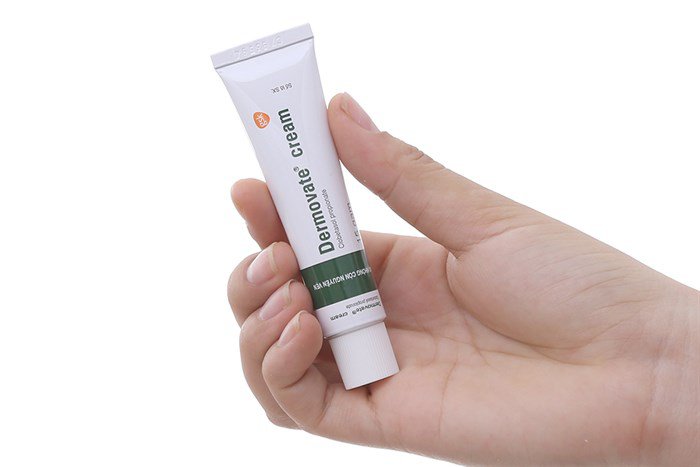
Dermovate Cream công dụng phụ có thể xuất hiện khi bạn sử dụng
8. Some notes when using Dermovate cream
Potential for interactions when co-administered with CYP3A4 inhibitors (such as ritonavir and itraconazole) because they inhibit the metabolism of corticosteroids, leading to increased systemic exposure. The degree of interaction depends on the dose, route of administration of the corticosteroid and the effectiveness of the CYP3A4 inhibitor; There are no data evaluating the effects of topical corticosteroids on fertility in humans. Clobetasol subcutaneously in rats showed no effect on fertility, however fertility was reduced at the highest dose; There are limited data on the use of Dermovate cream in pregnant women. The use of topical corticosteroids in pregnant animals may cause abnormalities in fetal development. However, this relationship in humans has not been confirmed, so it should be considered when using Dermovate in pregnant women, and only using the lowest dose for the shortest time if the effect is higher. the risk of harm; The use of topical corticosteroids such as Dermovate cream in nursing women has not been proven safe. There is no evidence that topical corticosteroids lead to systemic absorption and excretion into breast milk. However, women who are breastfeeding should consider this before using Dermovate cream and only if the benefit to the mother outweighs the risk to the baby. Note that Dermovate should not be applied to the breast to prevent the child from swallowing the medicine. Dermovate cream topical is a form of corticosteroid that is used very commonly, either systemic or topically. To ensure effective use, avoid causing side effects, patients need to take the drug exactly as directed.
Follow Vinmec International General Hospital website to get more health, nutrition and beauty information to protect the health of yourself and your loved ones in your family.
Please dial HOTLINE for more information or register for an appointment HERE. Download MyVinmec app to make appointments faster and to manage your bookings easily.
This article is written for readers from Sài Gòn, Hà Nội, Hồ Chí Minh, Phú Quốc, Nha Trang, Hạ Long, Hải Phòng, Đà Nẵng.


